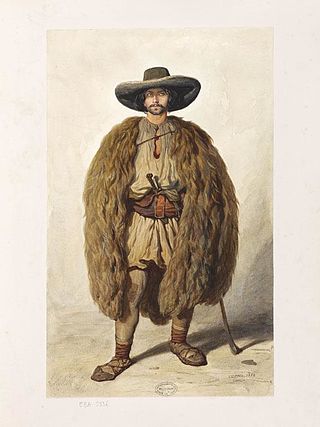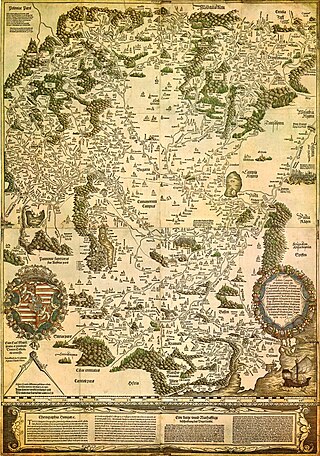
Taksony was the Grand Prince of the Hungarians after their catastrophic defeat in the 955 Battle of Lechfeld. In his youth he had participated in plundering raids in Western Europe, but during his reign the Hungarians only targeted the Byzantine Empire. The Gesta Hungarorum recounts that significant Muslim and Pecheneg groups settled in Hungary under Taksony.

Árpád was the head of the confederation of the Magyar tribes at the turn of the 9th and 10th centuries. He might have been either the sacred ruler or kende of the Hungarians, or their military leader or gyula, although most details of his life are debated by historians, because different sources contain contradictory information. Despite this, many Hungarians refer to him as the "founder of our country", and Árpád's preeminent role in the Hungarian conquest of the Carpathian Basin has been emphasized by some later chronicles. The dynasty descending from Árpád ruled the Kingdom of Hungary until 1301.

Vlach, also Wallachian, is a term and exonym used from the Middle Ages until the Modern Era to designate speakers of Eastern Romance languages living in Southeast Europe — south of the Danube and north of the Danube.

These are lists of political office-holders in Transylvania, from the 10th century, until 1867.

The Székelys, also referred to as Szeklers, are a Hungarian subgroup living mostly in the Székely Land in Romania. In addition to their native villages in Suceava County in Bukovina, a significant population descending from the Székelys of Bukovina currently lives in Tolna and Baranya counties in Hungary and certain districts of Vojvodina, Serbia.

Gesta Hungarorum, or The Deeds of the Hungarians, is the earliest book about Hungarian history which has survived for posterity. Its genre is not chronicle, but gesta, meaning "deeds" or "acts", which is a medieval entertaining literature. It was written in Latin by an unidentified author who has traditionally been called Anonymus in scholarly works. According to most historians, the work was completed between around 1200 and 1230. The Gesta exists in a sole manuscript from the second part of the 13th century, which was for centuries held in Vienna. It is part of the collection of Széchényi National Library in Budapest.
Menumorut or Menumorout was the ruler of the lands between the rivers Mureș, Someș and Tisza at the time of the Hungarian conquest of the Carpathian Basin around 900, according to the Gesta Hungarorum, a Hungarian chronicle written after 1150 by an unidentified author, referred to as Anonymus. Historians debate whether Menumorut was an actual ruler or a fictional character created by the author, since the Gesta tells of multiple figures, including Menumorut, who are not identified in any other primary sources, and does not name any of the enemies of the invading Hungarians written of in other contemporary accounts of the invasion. According to Anonymus, Menumorut's duchy was populated primarily with Khazars and Székelys, and he acknowledged the suzerainty of the (unnamed) ruling Byzantine Emperor at the time.
The Transylvanian peasant revolt, also known as the peasant revolt of Bábolna or Bobâlna revolt, was a popular revolt in the eastern territories of the Kingdom of Hungary in 1437. The revolt broke out after George Lépes, bishop of Transylvania, had failed to collect the tithe for years because of a temporary debasement of the coinage, but then demanded the arrears in one sum when coins of higher value were again issued. Most commoners were unable to pay the demanded sum, but the bishop did not renounce his claim and applied interdict and other ecclesiastic penalties to enforce the payment.

Gelou was the Vlach ruler of Transylvania at the time of the Hungarian conquest of the Carpathian Basin around 900 AD, according to the Gesta Hungarorum. Although the Gesta Hungarorum, which was written after 1150, does not indicate the enemies of the conquering Hungarians (Magyars) known from earlier annals and chronicles, it refers to local rulers—including Gelou—who are not mentioned in other primary sources. Consequently, historians debate whether Gelou was a historical person or an imaginary figure created by the unidentified author of the Gesta Hungarorum. In Romanian historiography, based on the mention of him by Anonymus some 300 years later, Gelou is considered one of three early-10th-century Romanian dukes with lands in the intra-Carpathian region of present-day Romania.

Ajtony, Ahtum or Achtum was an early-11th-century ruler in the territory now known as Banat in present Romania and Serbia. His primary source is the Long Life of Saint Gerard, a 14th-century hagiography. Ajtony was a powerful ruler who owned many horses, cattle and sheep and was baptised according to the Orthodox rite in Vidin. He taxed salt which was transferred to King Stephen I of Hungary on the Mureș River. The king sent Csanád, Ajtony's former commander-in-chief, against him at the head of a large army. Csanád defeated and killed Ajtony, occupying his realm. In the territory, at least one county and a Roman Catholic diocese were established.

Glad was the ruler of Banat at the time of the Hungarian conquest of the Carpathian Basin around 900 AD, according to the Gesta Hungarorum. The Gesta, which was written by an author known in modern scholarship as Anonymus in the second half of the 12th century or in the early 13th century, is the earliest extant Hungarian chronicle. The Gesta did not refer to the enemies of the conquering Hungarians, who had been mentioned in earlier annals and chronicles, but wrote of a dozen persons, including Glad, who are unknown from other primary sources of the Hungarian Conquest. Therefore, modern historians debate whether Glad was an actual enemy of the conquerors or only a "fictitious person" made up by Anonymus. In Romanian historiography, based on the mention by Anonymus some 300 years later, Glad is described as one of the three Romanian dukes who ruled a historical region of present-day Romania in the early 10th century.

Emese was the daughter of Duke Eunedubelianus of Dentumoger, the consort of the noblest Scythian prince Ügyek, and the mother of High Prince Álmos in Hungarian historical mythology; thus, she was the ancestress of the Hungarian royal house of Árpád, the dynasty which founded the Hungarian Kingdom. Due to a lack of reliable source material, it is difficult to separate the legends concerning Emese from her actual role as an historical person.

Transylvania is a historical region in central and northwestern Romania. It was under the rule of the Agathyrsi, part of the Dacian Kingdom, Roman Dacia (106–271), the Goths, the Hunnic Empire, the Kingdom of the Gepids, the Avar Khaganate, the Slavs, and the 9th century First Bulgarian Empire. During the late 9th century, Transylvania was part of the Hungarian conquest, and the family of Gyula II of the seven chieftains of the Hungarians ruled Transylvania in the 10th century. King Stephen I of Hungary asserted his claim to rule all lands dominated by Hungarian lords, and he personally led his army against his maternal uncle Gyula III. Transylvania became part of the Kingdom of Hungary in 1002, and it belonged to the Lands of the Hungarian Crown until 1920.
The Early Middle Ages in Romania started with the withdrawal of the Roman troops and administration from Dacia province in the 270s. In the next millennium a series of peoples, most of whom only controlled two or three of the nearly ten historical regions that now form Romania, arrived. During this period, society and culture underwent fundamental changes. Town life came to an end in Dacia with the Roman withdrawal, and in Scythia Minor – the other Roman province in the territory of present-day Romania – 400 years later. Fine vessels made on fast potter's wheels disappeared and hand-made pottery became dominant from the 450s. Burial rites changed more than once from cremation to inhumation and vice versa until inhumation became dominant by the end of the 10th century.
Gyula III, also Iula or Gyula the Younger, Geula or Gyla, was an early medieval ruler in Transylvania. Around 1003, he and his family were attacked, dispossessed and captured by King Stephen I of Hungary (1000/1001-1038). The name "Gyula" was also a title, the second highest rank in Hungarian tribal confederation.

The Hungarian conquest of the Carpathian Basin, also known as the Hungarian conquest or the Hungarian land-taking, was a series of historical events ending with the settlement of the Hungarians in Central Europe in the late 9th and early 10th century. Before the arrival of the Hungarians, three early medieval powers, the First Bulgarian Empire, East Francia, and Moravia, had fought each other for control of the Carpathian Basin. They occasionally hired Hungarian horsemen as soldiers. Therefore, the Hungarians who dwelt on the Pontic-Caspian Steppe east of the Carpathian Mountains were familiar with what would become their homeland when their conquest started.

The Duke of Transylvania was a title of nobility four times granted to a son or a brother of the Hungarian monarch. The dukes of the first and second creations, Béla (1226–1235) and Stephen of the Árpád dynasty were in fact viceroys with significant authority in Transylvania. The duke of the third creation, Louis, did not administer the province. The fourth duke, Stephen of the Anjou dynasty (1350–1351) did not play any significant role in politics.

Álmos, also Almos or Almus, was—according to the uniform account of Hungarian chronicles—the first head of the "loose federation" of the Hungarian tribes from around 850. Whether he was the sacred ruler (kende) of the Hungarians or their military leader (gyula) is subject to scholarly debate. According to Constantine Porphyrogenitus, he accepted the Khazar khagan's suzerainty in the first decade of his reign, but the Hungarians acted independently of the Khazars from around 860. The 14th-century Illuminated Chronicle narrates that he was murdered in Transylvania at the beginning of the Hungarian conquest of the Carpathian Basin around 895.
The "shepherds of the Romans" were a population living in the Carpathian Basin at the time of the Hungarian conquest of the territory around 900, according to the Gesta Hungarorum and other medieval sources.
Scholarly theories about the origin of the Székelys can be divided into four main groups. Medieval chronicles unanimously stated that the Székelys were descended from the Huns and settled in the Carpathian Basin centuries before the Hungarians conquered the territory in the late 9th century. This theory is refuted by most modern specialists. According to a widely accepted modern hypothesis, the Székelys were originally a Turkic people who joined the Magyars in the Pontic steppes. Another well-known theory states that the Székelys are simply Magyars, descended from the border guards of the Kingdom of Hungary who settled in the easternmost region of the Carpathian Basin and preserved their special privileges for centuries. According to a fourth theory, the Székelys' origin can be traced back to the Late Avar population of the Carpathian Basin.














